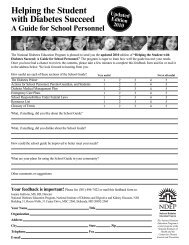Every Child Matters - Children with Diabetes
Every Child Matters - Children with Diabetes
Every Child Matters - Children with Diabetes
- No tags were found...
You also want an ePaper? Increase the reach of your titles
YUMPU automatically turns print PDFs into web optimized ePapers that Google loves.
Some do not, and this can be very worrying for the family. It is an importantissue that needs addressing where relevant.2.9 Choosing Health (2004) – Healthy schools – health andeducation going hand-in-hand (p55) <strong>Child</strong>ren spend an average of a quarter oftheir waking lives in school. The school environment, attitudes of the staff andother pupils, as well as what children learn, in the classroom, have a majorinfluence on the development of their knowledge and understanding of health.A Balancing Act3.1 A Balancing ActType 1 diabetes can present two faces. On one hand we want our children tofit in and be able to do the same things as their peers. We tell them thatdiabetes should not stop them doing anything that they want. However, to beable to do the same things as their peers, they need to take extra care andrequire support to do so. The youngest of the children will need a lot moresupport than children who are 9 or 10 years old. Though of course, the needsare very individual and older children still need support, and teachers alwaysneed to be aware that hypos can occur at any time <strong>with</strong>out childrenrecognising them. Older children sometimes need reminding about drinks orfood to treat hypos.Currently there is no consistency <strong>with</strong> help available in schoolsSome schools do manage to give excellent support and are happy or able toprovide support and help and work as a team <strong>with</strong> parents. Some examplesare given at the end of this document. Many schools try to get out of havingto provide any extra help in the classroom and are sometimes expectingchildren as young as four and five years old, who cannot yet even read andwrite, to take responsibility for totally managing their condition at school.A school’s duty is to provide education in a safe non-restrictiveenvironment for children <strong>with</strong> diabetes. How can a schoolsuccessfully educate our children, if it cannot provide a setting thatis conducive to learning?3.2 Why do children <strong>with</strong> diabetes need more help nowthan they did in the past?In the last 20 years there has been a significant increase in the numbers ofvery young children diagnosed <strong>with</strong> type 1 diabetes. At present the cause ofthe increase is unknown. This steep rise in the number of under fivesdiagnosed <strong>with</strong> diabetes, means that there are now many youngchildren starting infant school or nursery departments who havequite complex needs to be met. At the present time, 80% of children <strong>with</strong>diabetes are failing to maintain adequate glycaemic control and are not9





